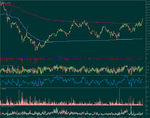grantx said:Following this thread has convinced me of the importance (primacy?) of volume. Some time ago I copied most of this thread into a Word document (and its one large file) for later study.
My problem was accessing and extracting relevant data from my feed. Now I’ve written an Excel programme to do this. This is the data I extract: time, last, last size, bid, ask, bid size, ask size.
From this I determine change from last, change on bid, change on ask, whether last trade was at bid, ask, mid, below bid, above ask. The time period can be tick onwards. I don’t know which of these is relevant or how to interpret the various elements. Would someone please give a brief synopsis, suggest other elements/factors to consider, improvements to the programme. I really don’t feel like trawling through that Word document at the moment.
Possibly of secondary value, I also record where the last is in relation to open, high, low, previous close, fair value.
Thank you in advance.
Grant.
IMHO this is the right approach. Speculative musings about smart money are all well and good, but nothing beats the hard graft of actually looking at the market. You could read this thread over on ET for discussion of market delta (ratio of trades at ask to trades at bid):
http://www.elitetrader.com/vb/showthread.php?s=&threadid=78980
Also read up on market profile. I have no doubt that some SIF markets 'take notice' of market profile levels.
A key component of understanding SIFs is to get a handle on how the order book behaves. I posted some stuff on the above thread that I think is interesting. If Paul Rotter says you gotta understand the order book to trade futures well, that is good enough for me.


